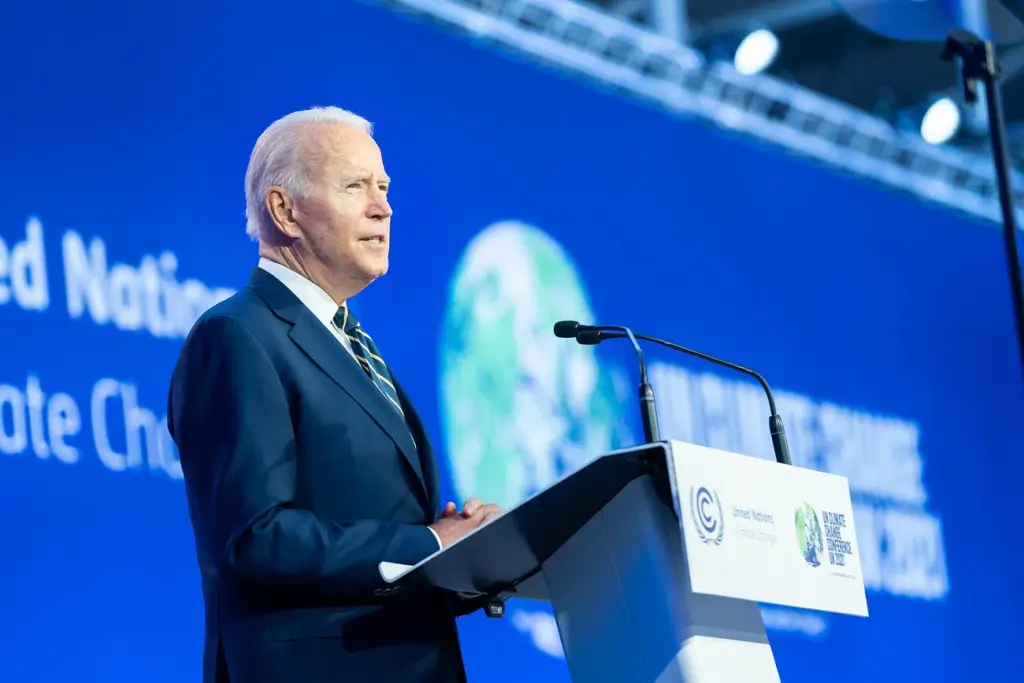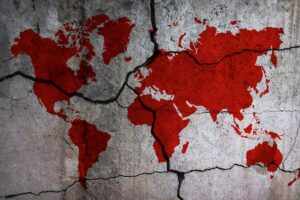The Red cell project
The Red Cell was a small unit created by the CIA after 9/11 to ensure the analytic failure of missing the attacks would never be repeated. It produced short briefs intended to spur out-of-the-box thinking on flawed assumptions and misperceptions about the world, encouraging alternative policy thinking. At another pivotal time of increasing uncertainty, this project is intended as an open-source version, using a similar format to question outmoded mental maps and “strategic empathy” to discern the motives and constraints of other global actors, enhancing the possibility of more effective strategies.
Can the United States meet its climate goals without US-China cooperation? The Biden administration is making a risky bet that its efforts to produce electric vehicles (EVs) and master other green technologies without China’s inputs will prove successful.
The IRA and CHIPS1IRA is the Inflation Reduction Act of 2022; CHIPS is the Creating Helpful Incentives to Produce Semiconductors Act of 2022. The IRA directs nearly $400 billion in federal funding to clean energy, with the goal of substantially lowering the nation’s carbon emissions by the end of this decade. The funds will be delivered through a mix of tax incentives, grants, and loan guarantees. Clean electricity and transmission command the biggest slice, followed by clean transportation, including EV incentives. The CHIPS Act directs $280 billion in spending over the next ten years. The majority — $200 billion — is for scientific R&D and commercialization. Some $52.7 billion is for semiconductor manufacturing, R&D, and workforce development, with another $24 billion worth of tax credits for chip production. The Act stipulates that $3 billion be spent on programs aimed at leading-edge technology and wireless supply chains. subsidies for EVs, wind, solar, and other green energies, as well as for semiconductors needed for their development, are premised on excluding China in favor of production at home with some “friend-shoring.” Together IRA and CHIPS constitute the biggest U.S. attempt at industrial policy ever, a stinging turnaround for the U.S. government, which used to disparage other countries’ attempts at state-directed industrialization and protectionism. In effect, the U.S. is trying to beat China at its own game. For decades, the Chinese government has been injecting capital into green technologies, borrowing innovations from elsewhere but being expert at producing at scale and monopolizing the global green technology marketplace.
Many economists across the political spectrum are skeptical that the United States can go green on its own without raising the costs of green technologies, setting off a race to the bottom with allies and friends, or providing a windfall to companies and their shareholders. Of particular concern is that Washington is dealing from a position of weakness as long as it restricts new EVs to being assembled in the United States with certain battery components and minerals coming from approved “friendly” countries rather than China.
The problem is that the “supply chain for renewable energy technology is even more concentrated than for fossil fuels,” with China refining 80% of all rare earth minerals, 95% of the world’s cobalt vital for the production of lithium-ion batteries, and making 70% of silica-based solar photovoltaic modules and possessing three-quarters of global EV battery production capacity. China also builds battery factories at practically half the cost of those built in the United States or Europe, according to Heiner Heimes, a professor at RWTH Aachen University in Germany, due to lower labor costs and having more equipment manufacturers.
Some promising initiatives are under way to diversify battery supplies, but it will take some years to develop this capability at scale. The Biden administration announced in 2022 a plan to encourage major investments in domestic critical minerals supplies as a way of “breaking dependence on China.” But, as one analyst has warned, “China’s green advances are one reason that the older industrialized economies have gotten as far as they have in reducing the global economy’s carbon footprint.” Moreover, Chinese overproduction is a major reason why solar panel prices have fallen 80% during the past two decades.
Complete decoupling now would most likely slow down the improvements made so far in decreasing the carbon footprint of the major emitting countries. According to Benchmark Minerals, a consulting group, “despite billions in Western investment, China is so far ahead — mining rare minerals, training engineers and building huge factories — that the rest of the world may take decades to catch up. Even by 2030, China will make more than twice as many batteries as every other country combined.”
The issue of imported solar panels from Southeast Asian countries has been an early wake-up call for the administration on China’s pivotal role in green technologies. U.S. manufacturers have charged that Chinese companies moved their operations to four Southeast Asian countries — Cambodia, Malaysia, Thailand and Vietnam — to avoid U.S. anti-dumping rules. Congress passed a resolution in Spring 2023 that would have put tariffs on solar panels from those countries, but President Joe Biden recently vetoed the measure. “The mere threat of up to $1 billion in retroactive tariffs and higher fees led to delays or cancellations of hundreds of solar projects across the U.S. last year.” The hope is that in two years (when the veto expires) U.S. industries will be able to better compete with China in this realm. Solar is a key ingredient in the administration’s efforts to see 100% “clean electricity” by 2035.
“The United States needs to find a balance and discover how much dependence on China it can live with,” according to Center for Strategic and International Studies expert Nikos Tsafos, who testified last year before Congress’ US-China Economic and Security Review Commission. “Right now, the United States is a major energy provider to China. That gives the United States some leverage — losing these flows would hurt China a lot.”
Running Into a Brick Wall at Home
“In theory,” as one U.S. analyst has warned, “climate competition between the two superpowers could lead to a ‘race to the top’ on deploying green technologies and combating climate change.” US-China cooperation “helped pave the way for the Paris Climate Agreement in 2015, and reignited flailing international climate negotiation in Glasgow in 2021.”
The current one-upmanship that observers note, however, is leading both countries to make pledges they are unlikely to keep. The Biden administration congratulated itself earlier this year on delivering a $1 billion contribution to the Green Climate Fund, which President Barack Obama helped to found and aimed at preparing the developing world for climate change, promoting a paradigm shift to low-emission and climate-resilient development. Nevertheless, President Biden has promised that the United States will spend $11.4 billion annually by 2024 on helping developing countries, which is unlikely to happen given the current rate of spending. The Democrats had proposed $3.4 billion, itself a relatively small amount in view of the goal, which was cut back by over two-thirds by Republicans. During the Trump administration, the U.S. did not contribute at all. The $1 billion contribution “moves the US up to fifth place in terms of paid-in funds, after Japan, France, Germany, and the UK,” much smaller economies.
China has its own problems as a result of making too many promises. President Xi Zinping’s anti-coal pledge on future power plants construction as part of his Belt and Road Initiative lacks “a timeline on its implementation” and “contains vague language that gives wiggle room for some coal investments.” At home, coal power accelerated dramatically in China in 2022, “with new permits reaching the highest level since 2015.” Beijing is also trying to create a “made-in-China” economy that eschews dependence on the United States, fueled by worries of sanctions against its champions, such as happened with Huawei’s mobile phone business that was seriously damaged by U.S. and other allied countries’ restrictions.
For the competition to be constructive, China and the United States will have to turn away from the drive toward self-sufficiency — which risks a global slowdown on achieving climate goals and is not necessarily good for generating the large-scale investments to combat climate change. The IMF estimates that the formation of a U.S. bloc and a China bloc could reduce global growth by as much as 2% over the longer term. As the world’s largest economy, the United States will account for a significant share of foregone economic growth, hurting the middle class, which the Biden administration says it wants to help.
From Win-Win to Lose-Lose
The Biden administration is right to try to marry an economic and manufacturing resurgence with combating climate change. Many of the new EV-related manufacturing sites are in “red” states, increasing the potential for conservative buy-in to the climate cause and the new investments that follow. But given China’s first-mover advantages, such a laudable effort would leave a sour taste if all the subsidies do not instantly rebuild U.S. manufacturing prowess.
Jensen Huang, the chief executive of Nvidia, the world’s most valuable semiconductor company, has warned that the U.S. tech industry is at risk of “enormous damage” from the escalating battle over chips between Washington and Beijing. In an interview with the Financial Times, Huang charges the Biden administration’s export controls on sales of high-end semi-conductors to slow Chinese semiconductor manufacturing “ha[s] left the Silicon Valley group with ‘our hands tied behind our back’ and unable to sell advanced chips in one of the company’s biggest markets.” What is more, “the Chinese companies [are] starting to build their own chips to rival Nvidia’s…”
Because the U.S. economy has been so intertwined with China’s economy, too abrupt a break would hurt the United States and set back efforts to fight climate change, a truly existential global challenge. U.S. policymakers need a greater understanding of where and how to draw the line against Chinese trade and investments even as the goal of leading the world in green technologies is admirable and desirable.
It will take some time for the new U.S. investments to lead to new types of green technologies that are less reliant on cobalt and lithium, the processing of which is a near-Chinese monopoly. Too great a drive at edging out the Chinese could sidetrack the bigger goal of achieving a carbon-neutral world.
Notes
- 1IRA is the Inflation Reduction Act of 2022; CHIPS is the Creating Helpful Incentives to Produce Semiconductors Act of 2022. The IRA directs nearly $400 billion in federal funding to clean energy, with the goal of substantially lowering the nation’s carbon emissions by the end of this decade. The funds will be delivered through a mix of tax incentives, grants, and loan guarantees. Clean electricity and transmission command the biggest slice, followed by clean transportation, including EV incentives. The CHIPS Act directs $280 billion in spending over the next ten years. The majority — $200 billion — is for scientific R&D and commercialization. Some $52.7 billion is for semiconductor manufacturing, R&D, and workforce development, with another $24 billion worth of tax credits for chip production. The Act stipulates that $3 billion be spent on programs aimed at leading-edge technology and wireless supply chains.




